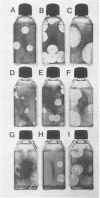Abstract
Infectious cDNA corresponding to the entire genome of the attenuated Sabin strain of type 1 poliovirus has been inserted into EcoRI site of bacterial plasmid pBR325. Two consecutive PstI fragments (nucleotide positions 1814 to 3421) of the infectious cDNA of the Sabin 1 strain were replaced by the corresponding DNA fragments prepared from an infectious DNA clone of the genome of the virulent Mahoney strain of poliovirus type 1. The exchanged segment encodes capsid protein VP1 and part of capsid protein VP3, a region in which a large number of amino acid differences between the attenuated Sabin and the parental, neurovirulent Mahoney strain cluster. The recombinant virus was obtained by DNA transfection of HeLa S3 cells, and several in vitro phenotypes of the virus were compared with those of the parental viruses. The recombinant virus was recognized by a neutralizing monoclonal antibody specific to the Mahoney strain. Growth of the Sabin strain of poliovirus has been shown to be quite dependent upon the bicarbonate concentration (d marker). The growth of the recombinant virus, however, was not highly dependent upon the concentration of bicarbonate in cell culture media, and thus resembled that of the Mahoney strain. On the other hand, the temperature-sensitive multiplication (rct marker) and the small-plaque morphology of the recombinant virus corresponded to the phenotype of the Sabin 1 strain. The in vitro recombination of infectious cDNA clones of genomic RNA and subsequent analysis of the growth properties of the recombinant virus have allowed us to correlate specific mutations in the genome of an RNA virus with certain biological characteristics of that virus.
Full text
PDF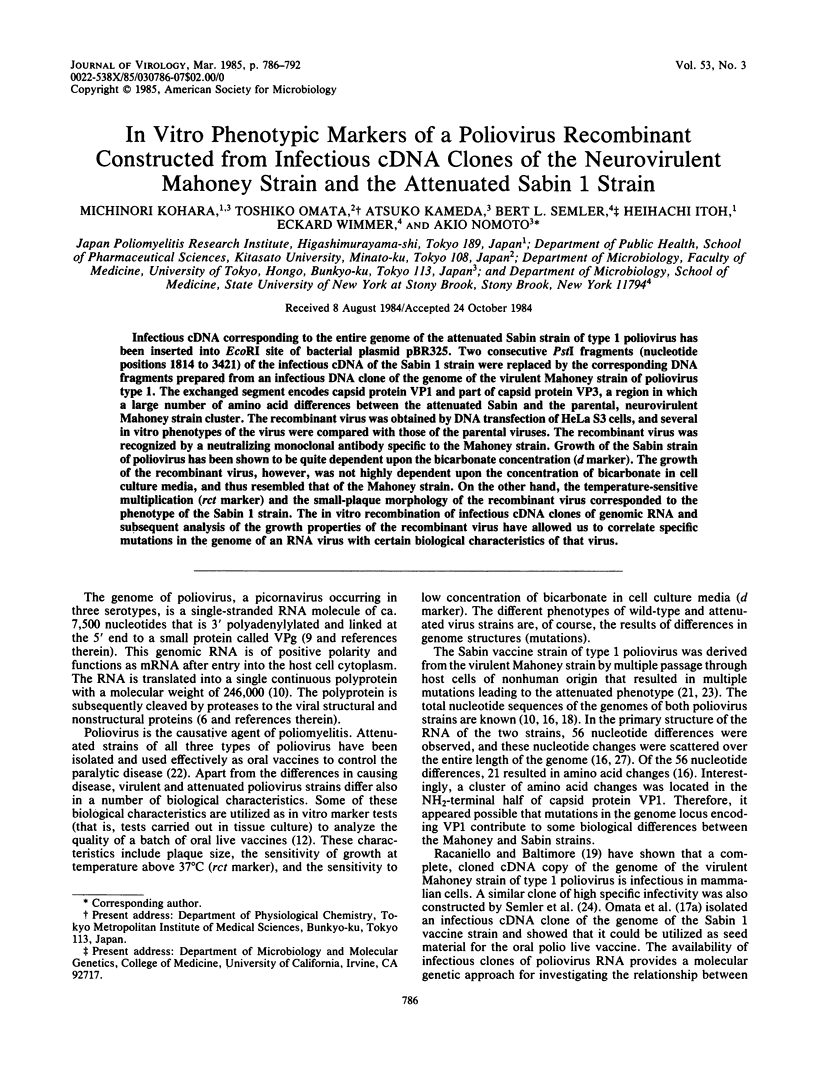
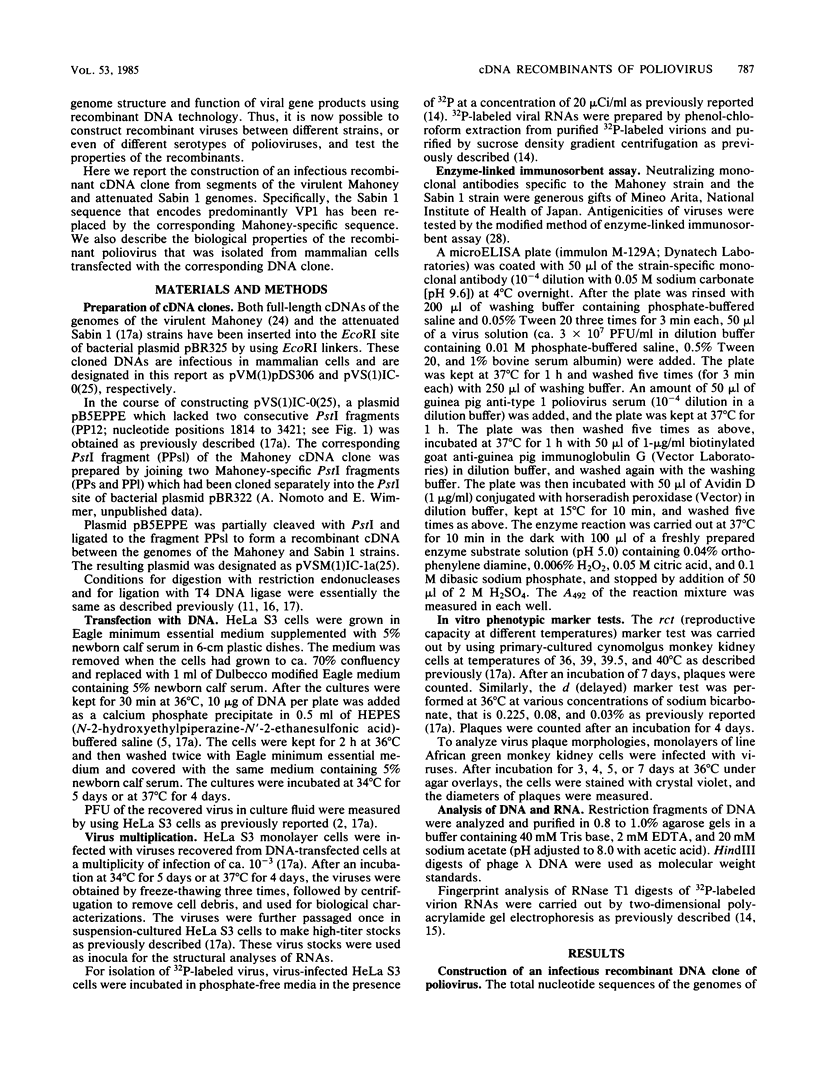
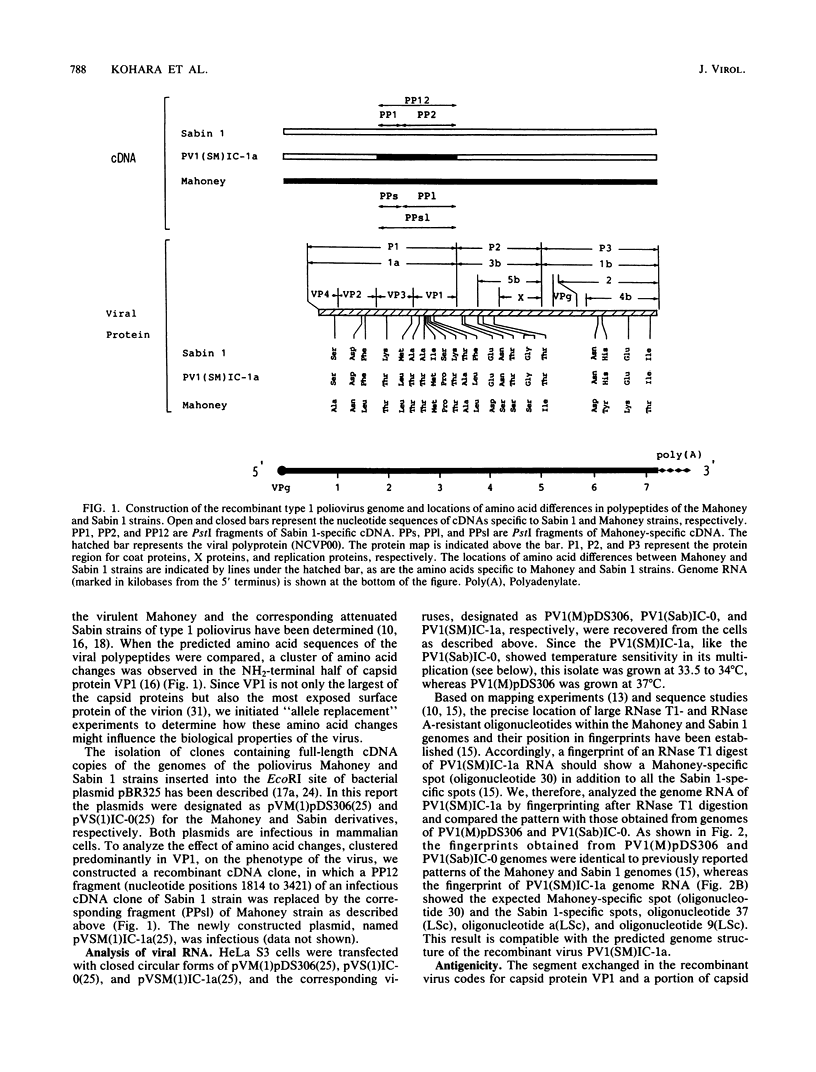
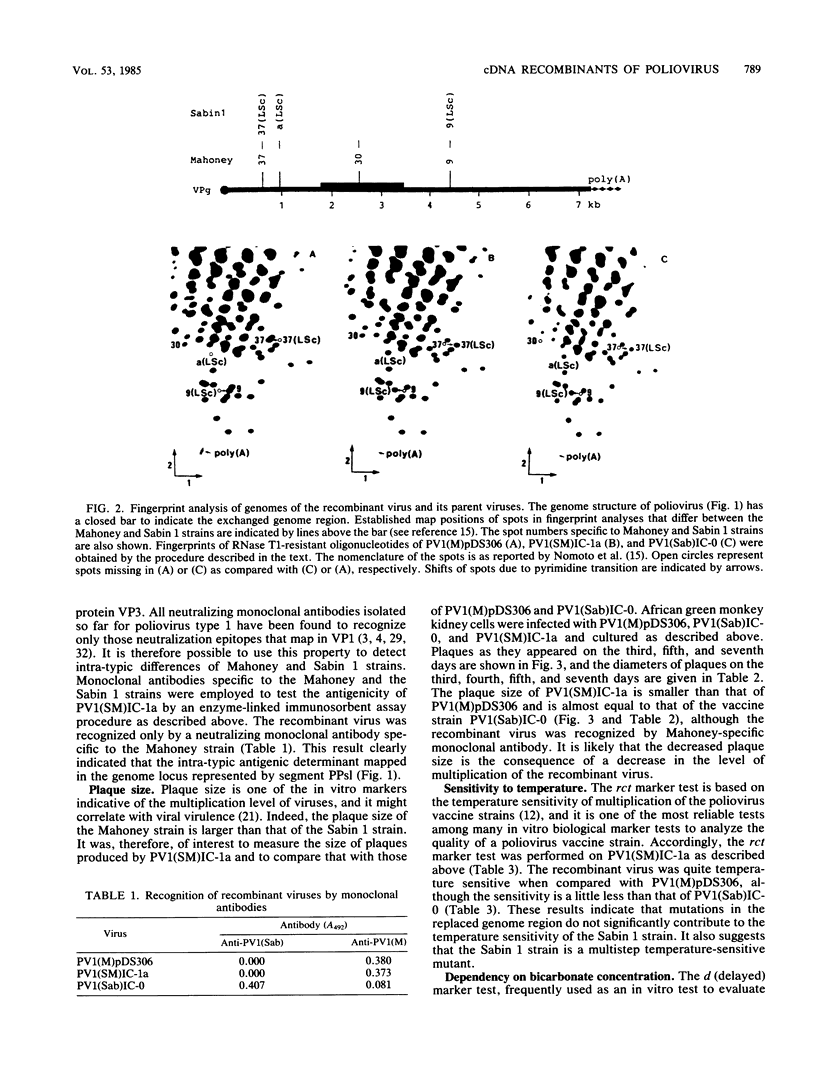
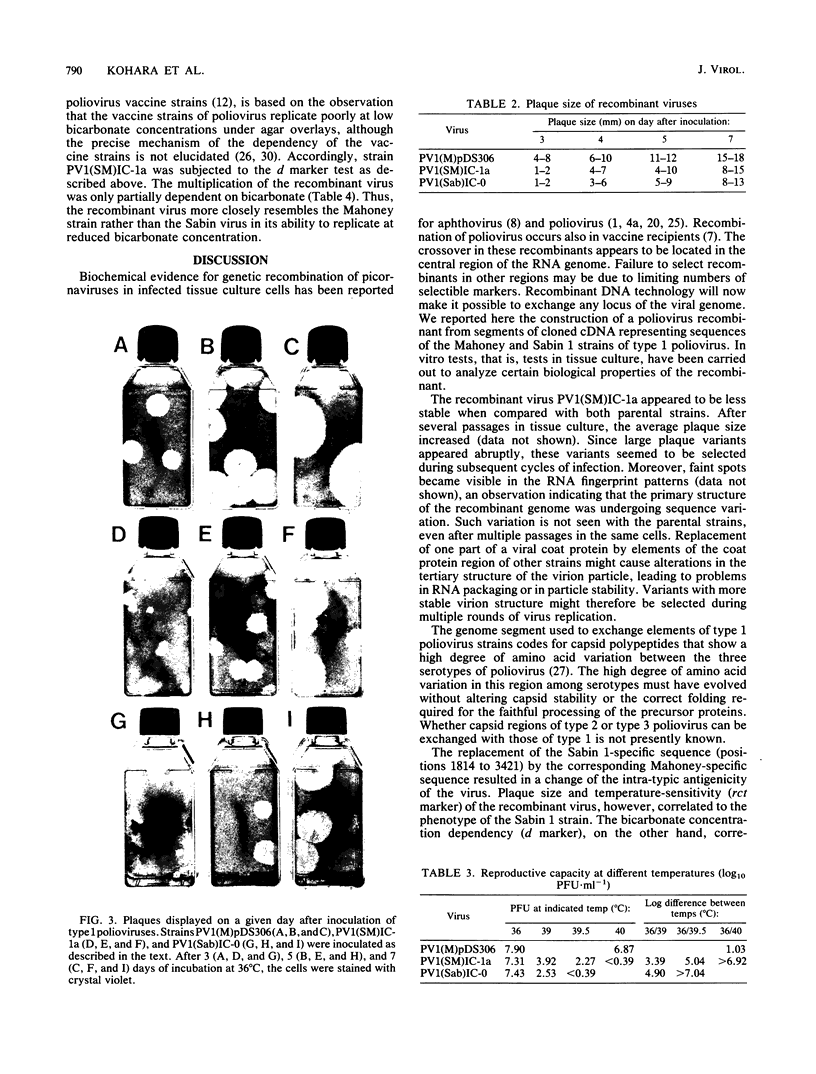
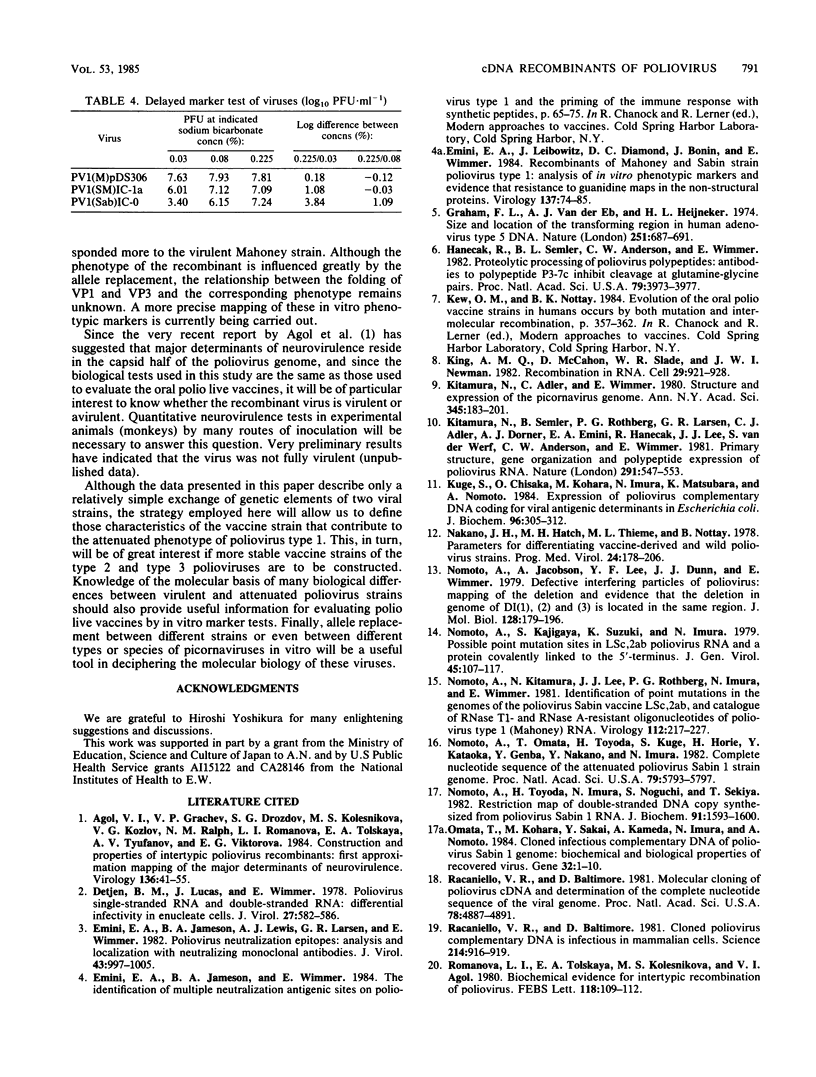
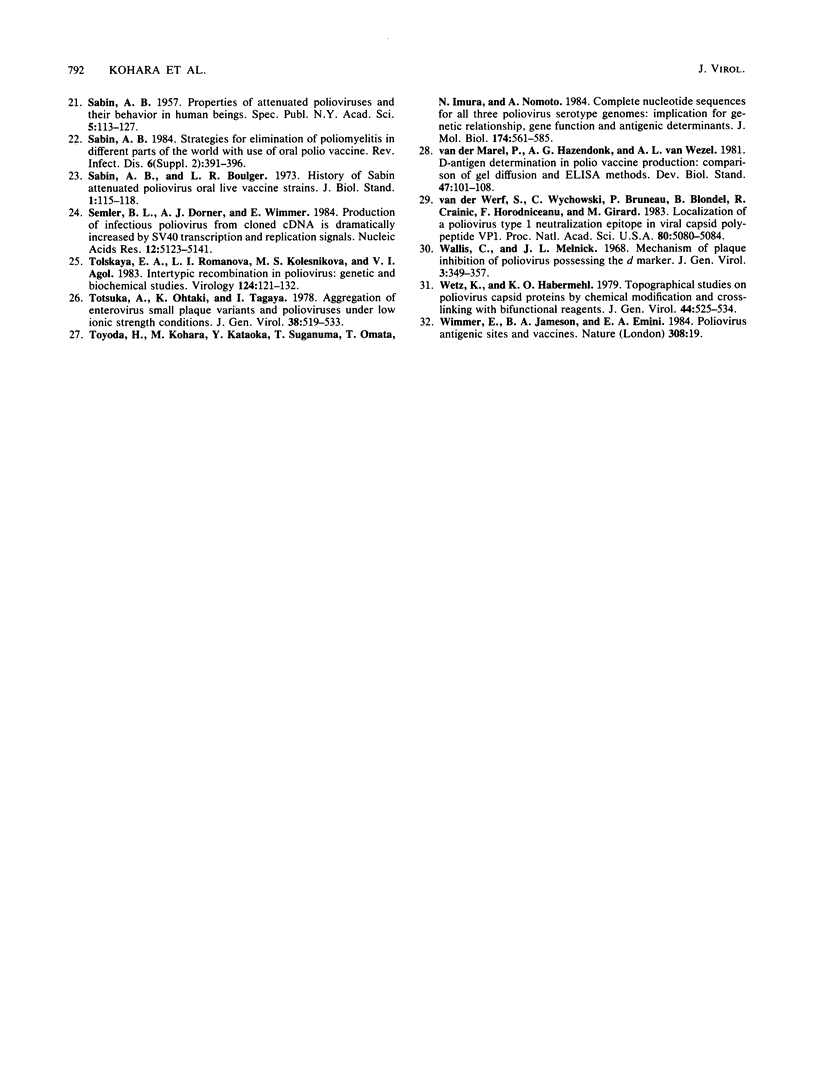
Images in this article
Selected References
These references are in PubMed. This may not be the complete list of references from this article.
- Agol V. I., Grachev V. P., Drozdov S. G., Kolesnikova M. S., Kozlov V. G., Ralph N. M., Romanova L. I., Tolskaya E. A., Tyufanov A. V., Viktorova E. G. Construction and properties of intertypic poliovirus recombinants: first approximation mapping of the major determinants of neurovirulence. Virology. 1984 Jul 15;136(1):41–55. doi: 10.1016/0042-6822(84)90246-0. [DOI] [PubMed] [Google Scholar]
- Detjen B. M., Lucas J., Wimmer E. Poliovirus single-stranded RNA and double-stranded RNA: differential infectivity in enucleate cells. J Virol. 1978 Sep;27(3):582–586. doi: 10.1128/jvi.27.3.582-586.1978. [DOI] [PMC free article] [PubMed] [Google Scholar]
- Emini E. A., Jameson B. A., Lewis A. J., Larsen G. R., Wimmer E. Poliovirus neutralization epitopes: analysis and localization with neutralizing monoclonal antibodies. J Virol. 1982 Sep;43(3):997–1005. doi: 10.1128/jvi.43.3.997-1005.1982. [DOI] [PMC free article] [PubMed] [Google Scholar]
- Emini E. A., Leibowitz J., Diamond D. C., Bonin J., Wimmer E. Recombinants of Mahoney and Sabin strain poliovirus type 1: analysis of in vitro phenotypic markers and evidence that resistance to guanidine maps in the nonstructural proteins. Virology. 1984 Aug;137(1):74–85. doi: 10.1016/0042-6822(84)90010-2. [DOI] [PubMed] [Google Scholar]
- Graham F. L., van der Eb A. J., Heijneker H. L. Size and location of the transforming region in human adenovirus type 5 DNA. Nature. 1974 Oct 25;251(5477):687–691. doi: 10.1038/251687a0. [DOI] [PubMed] [Google Scholar]
- Hanecak R., Semler B. L., Anderson C. W., Wimmer E. Proteolytic processing of poliovirus polypeptides: antibodies to polypeptide P3-7c inhibit cleavage at glutamine-glycine pairs. Proc Natl Acad Sci U S A. 1982 Jul;79(13):3973–3977. doi: 10.1073/pnas.79.13.3973. [DOI] [PMC free article] [PubMed] [Google Scholar]
- King A. M., McCahon D., Slade W. R., Newman J. W. Recombination in RNA. Cell. 1982 Jul;29(3):921–928. doi: 10.1016/0092-8674(82)90454-8. [DOI] [PMC free article] [PubMed] [Google Scholar]
- Kitamura N., Adler C., Wimmer E. Structure and expression of the picornavirus genome. Ann N Y Acad Sci. 1980;354:183–201. doi: 10.1111/j.1749-6632.1980.tb27967.x. [DOI] [PubMed] [Google Scholar]
- Kitamura N., Semler B. L., Rothberg P. G., Larsen G. R., Adler C. J., Dorner A. J., Emini E. A., Hanecak R., Lee J. J., van der Werf S. Primary structure, gene organization and polypeptide expression of poliovirus RNA. Nature. 1981 Jun 18;291(5816):547–553. doi: 10.1038/291547a0. [DOI] [PubMed] [Google Scholar]
- Kuge S., Chisaka O., Kohara M., Imura N., Matsubara K., Nomoto A. Expression of poliovirus complementary DNA coding for viral antigenic determinants in Escherichia coli. J Biochem. 1984 Aug;96(2):305–312. doi: 10.1093/oxfordjournals.jbchem.a134839. [DOI] [PubMed] [Google Scholar]
- Nakano J. H., Hatch M. H., Thieme M. L., Nottay B. Parameters for differentiating vaccine-derived and wild poliovirus strains. Prog Med Virol. 1978;24:178–206. [PubMed] [Google Scholar]
- Nomoto A., Jacobson A., Lee Y. F., Dunn J., Wimmer E. Defective interfering particles of poliovirus: mapping of the deletion and evidence that the deletions in the genomes of DI(1), (2) and (3) are located in the same region. J Mol Biol. 1979 Feb 25;128(2):179–196. doi: 10.1016/0022-2836(79)90125-6. [DOI] [PubMed] [Google Scholar]
- Nomoto A., Kajigaya S., Suzuki K., Imura N. Possible point mutation sites in LSc, 2ab poliovirus RNA and a protein covalently linked to the 5'-terminus. J Gen Virol. 1979 Oct;45(1):107–117. doi: 10.1099/0022-1317-45-1-107. [DOI] [PubMed] [Google Scholar]
- Nomoto A., Kitamura N., Lee J. J., Rothberg P. G., Imura N., Wimmer E. Identification of point mutations in the genome of the poliovirus Sabin vaccine LSc 2ab, and catalogue of RNase T1- and RNase A-resistant oligonucleotides of poliovirus type 1 (Mahoney) RNA. Virology. 1981 Jul 15;112(1):217–227. doi: 10.1016/0042-6822(81)90627-9. [DOI] [PubMed] [Google Scholar]
- Nomoto A., Omata T., Toyoda H., Kuge S., Horie H., Kataoka Y., Genba Y., Nakano Y., Imura N. Complete nucleotide sequence of the attenuated poliovirus Sabin 1 strain genome. Proc Natl Acad Sci U S A. 1982 Oct;79(19):5793–5797. doi: 10.1073/pnas.79.19.5793. [DOI] [PMC free article] [PubMed] [Google Scholar]
- Nomoto A., Toyoda H., Imura N., Noguchi S., Sekiya T. Restriction map of double-stranded DNA copy synthesized from poliovirus Sabin 1 RNA. J Biochem. 1982 May;91(5):1593–1600. doi: 10.1093/oxfordjournals.jbchem.a133850. [DOI] [PubMed] [Google Scholar]
- Omata T., Kohara M., Sakai Y., Kameda A., Imura N., Nomoto A. Cloned infectious complementary DNA of the poliovirus Sabin 1 genome: biochemical and biological properties of the recovered virus. Gene. 1984 Dec;32(1-2):1–10. doi: 10.1016/0378-1119(84)90026-x. [DOI] [PubMed] [Google Scholar]
- Racaniello V. R., Baltimore D. Cloned poliovirus complementary DNA is infectious in mammalian cells. Science. 1981 Nov 20;214(4523):916–919. doi: 10.1126/science.6272391. [DOI] [PubMed] [Google Scholar]
- Racaniello V. R., Baltimore D. Molecular cloning of poliovirus cDNA and determination of the complete nucleotide sequence of the viral genome. Proc Natl Acad Sci U S A. 1981 Aug;78(8):4887–4891. doi: 10.1073/pnas.78.8.4887. [DOI] [PMC free article] [PubMed] [Google Scholar]
- Romanova L. I., Tolskaya E. A., Kolesnikova M. S., Agol V. I. Biochemical evidence for intertypic genetic recombination of polioviruses. FEBS Lett. 1980 Aug 25;118(1):109–112. doi: 10.1016/0014-5793(80)81229-4. [DOI] [PubMed] [Google Scholar]
- Semler B. L., Dorner A. J., Wimmer E. Production of infectious poliovirus from cloned cDNA is dramatically increased by SV40 transcription and replication signals. Nucleic Acids Res. 1984 Jun 25;12(12):5123–5141. doi: 10.1093/nar/12.12.5123. [DOI] [PMC free article] [PubMed] [Google Scholar]
- Tolskaya E. A., Romanova L. A., Kolesnikova M. S., Agol V. I. Intertypic recombination in poliovirus: genetic and biochemical studies. Virology. 1983 Jan 15;124(1):121–132. doi: 10.1016/0042-6822(83)90295-7. [DOI] [PubMed] [Google Scholar]
- Totsuka A., Ohtaki K., Tagaya I. Aggregation of enterovirus small plaque variants and polioviruses under low ionic strength conditions. J Gen Virol. 1978 Mar;38(3):519–533. doi: 10.1099/0022-1317-38-3-519. [DOI] [PubMed] [Google Scholar]
- Toyoda H., Kohara M., Kataoka Y., Suganuma T., Omata T., Imura N., Nomoto A. Complete nucleotide sequences of all three poliovirus serotype genomes. Implication for genetic relationship, gene function and antigenic determinants. J Mol Biol. 1984 Apr 25;174(4):561–585. doi: 10.1016/0022-2836(84)90084-6. [DOI] [PubMed] [Google Scholar]
- Wallis C., Melnick J. L. Mechanism of plaque inhibition of poliovirus possessing the d marker. J Gen Virol. 1968 Dec;3(3):349–357. doi: 10.1099/0022-1317-3-3-349. [DOI] [PubMed] [Google Scholar]
- Wetz K., Habermehl K. O. Topographical studies on poliovirus capsid proteins by chemical modification and cross-linking with bifunctional reagents. J Gen Virol. 1979 Aug;44(2):525–534. doi: 10.1099/0022-1317-44-2-525. [DOI] [PubMed] [Google Scholar]
- Wimmer E., Jameson B. A., Emini E. A. Poliovirus antigenic sites and vaccines. Nature. 1984 Mar 1;308(5954):19–19. doi: 10.1038/308019a0. [DOI] [PubMed] [Google Scholar]
- van der Marel P., Hazendonk A. G., van Wezel A. L. D-antigen determination in polio vaccine production: comparison of gel diffusion and ELISA methods. Dev Biol Stand. 1981;47:101–108. [PubMed] [Google Scholar]
- van der Werf S., Wychowski C., Bruneau P., Blondel B., Crainic R., Horodniceanu F., Girard M. Localization of a poliovirus type 1 neutralization epitope in viral capsid polypeptide VP1. Proc Natl Acad Sci U S A. 1983 Aug;80(16):5080–5084. doi: 10.1073/pnas.80.16.5080. [DOI] [PMC free article] [PubMed] [Google Scholar]




